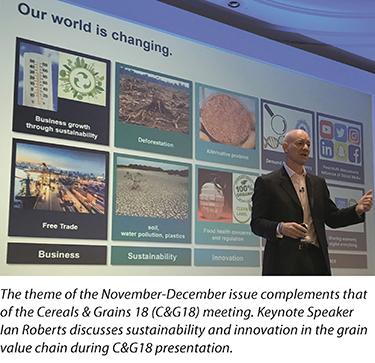 The Merriam-Webster dictionary defines innovation as “the introduction of something new.” Innovation is the process by which science and invention are converted into commercially viable products. This issue of Cereal Foods World explores innovation along the entire market value chain for cereal foods—from producers to retail settings.
The Merriam-Webster dictionary defines innovation as “the introduction of something new.” Innovation is the process by which science and invention are converted into commercially viable products. This issue of Cereal Foods World explores innovation along the entire market value chain for cereal foods—from producers to retail settings.
Cereal scientists must be aware of emerging consumer and end-user opportunities in order to create new product solutions. Emerging and dynamic consumer priorities, like non-GMO and organic ingredients, and diets like ketogenic, paleo, and Whole30 constantly change the food landscape. Seizing these opportunities requires awareness of consumer trends, disciplined use of basic and applied scientific and regulatory principles, and strong business acumen to successfully commercialize inventions. In effect, cereal scientists and engineers are very often the bridge between upstream capability and downstream demands that enable innovation to take place and be successful.
In this issue, we also challenge the narrow view that disruptive innovations (e.g., the iPhone created the smartphone category) are all that matter. The rare examples of disruptive innovation get a lot of fanfare, but incremental innovations accumulatively propel industries forward. Innovation is hard to quantify, especially when it is incremental.
Two articles in this issue illustrate incremental innovation in grains and milling. Kevin Kephart and his coauthors explain how Indigo Ag has developed a seed treatment that will drive efficiencies and improve sustainability through lower agronomic inputs (e.g., pesticides, herbicides, fertilizers, etc.) without altering the fundamental growing process. A panel discussion on “Incremental Innovation in the Milling Industry” showcases how various companies bring meaningful, smaller innovations to well-established processes.

Bringing innovation to any industry can be a challenge, but it can be enabled through creative problem-solving tools and processes. Lauren Shimek from Food.Tech.Design applies design thinking, an innovation model that has been gaining traction in the high-tech and healthcare industries, to various steps in the cereal and grain value chain. Brian Nash from Ingredion delves into a key step in today’s value chain—global sourcing of ingredients. Nash describes how a multinational corporation can successfully source sustainable raw materials on a global scale.
At the retail end of the value chain, dramatic shifts experienced in the past few years are expected to accelerate over the next several years. The rise of Amazon grocery delivery and its purchase of Whole Foods may provide a glimpse into the future, where brick-and-mortar retailers will integrate online shopping with “click and collect” grocery and “meal kit” delivery services. Wendy Liebmann from WSL Strategic Retail addresses these and other key consumer retail trends and reveals how meaningful (and often overlooked) retail solutions can create value.
Industries around us are innovating at a rapid pace—for example, artificial intelligence has exploded across multiple industries. Although consumers are generally quick to embrace technology innovations in other industries, they are more reluctant to accept and make giant leaps into the unknown with something as fundamental to survival as the food they eat. Lin Carson from BAKERpedia addresses how alluring messages can be utilized to overcome consumer resistance to technological breakthroughs in the foods they eat. Her article also provides guidance on crafting consumer-friendly messages across multiple digital platforms.
The collection of articles published in this issue reveals the range of opportunities available to bring cereal and grain innovations to the marketplace. Regardless of where innovation occurs in the value chain, it requires agility to connect capability and science to marketplace demand.
